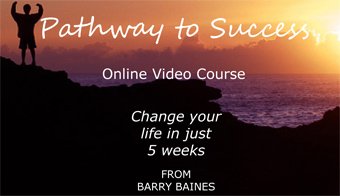More goal setting tools
NLP techniques
Build on a well-formed outcome
You will be ready for more goal setting tools if you have read Goal setting tools and Goal setting tips because you will have established a well-formed outcome and will understand some of the basics.
Every ceiling, when reached, becomes a floor upon which one walks as a matter of course and prescriptive right
Aldous Huxley

Now that you have got this far, remember that there is nothing that can stop you achieving your dream except quitting. Too many people quit when they are on the brink of success.
It is perfectly natural to have setbacks along the way, but those who succeed keep right on to the end of the road.
If you have read the article on this website entitled How to
hypnotise your audience, you will already be familiar with the concept of
spatial anchoring.
If not, it may be a good idea to click the link and run over it.
NLP anchoring in all its forms is an extremely useful
technique and the pages dedicated to it on this website are amongst our most
popular and read worldwide.
It is strongly recommended that you make yourself thoroughly familiar with them.
More goal setting tools and the founders of NLP
You will probably know that Richard Bandler and John Grinder collated and extended the principles they discovered when modelling eminent people such as Milton Erickson, Virginia Satir and Fritz Perls when founding what has become known as neurolinguistic programming, or NLP for short.
Although Bandler and Grinder were the leading lights and true founders of NLP, there were other student followers in the early days, some of whom co-authored publications and went on to produce variations of their own.
One of those was Robert Dilts whose specific interest at the time was creativity and who spent time modelling Walt Disney.
More goal setting tools with Walt Disney
Walt Disney had a special strategy for his creative writing team. He used three separate rooms. The first room was known as the dreamers’ room.
I expect you have had ideas in the past only to be knocked down at the first hurdle when someone immediately raises what they perceive as a difficulty.
That cannot happen in the dreamers’ room because here the dreamers could envisage any possibility without limit and it would not be subjected to criticism.
In this room they thought of the future, asked open questions and dreamed dreams. Imagination was permitted to roam freely without hindrance.
The second room was known as the realist room. Once the dreamers had dreamed their dreams and were satisfied that they were finished, they all went into the second room to discuss what were the most realistic ideas.
Although they were discussing what were the likely best ideas from the bunch, even at this stage there was no criticism of any ideas as such.
Finally, they all moved to the third room which was called the critic room. In this room they pulled the ideas apart, criticised and challenged them.
This strategy allows ideas to flow freely. It ensures that good ideas are not crushed in their infancy, but are allowed to blossom and grow before they are subject to hard challenge. So it stimulates creativity.
More goal setting tools and using the three rooms
It is a method you might like to try for yourself. If you are immediately thinking, “Well, I don’t have three rooms I can set apart for this purpose”, don’t worry too much about it.
Provided you have some sort of space (even if it is outside) we can use the concept of spatial anchoring to achieve the same ends.
All you need to do is to select three areas which you can label Dreamer, Realist and Critic. You don’t need to write them down as long as you know which areas represent which room, but if it helps there is no reason why you shouldn’t.
More goal setting tools and the dreamer
Using NLP anchoring you may anchor feelings to each area to assist you as you use them. Firstly, you might like to recall a time when you were at your most creative. When you have recalled that time, move to the Dreamer space.
As before, remember to see what you saw, feel what you felt and hear what you heard. If there were smells and tastes associated with the creative experience, recall them too. Intensify the experience.
Now walk away from the space. Break the state by doing something else for a moment and then test the anchor by re-entering the space and reliving the experience. Now leave the space again.
More goal setting tools and the dreamer
Now be realistic. Remember a time when you created a realistic plan to make something happen. Follow exactly the same procedure.
Build the experience by seeing what you saw, hearing what you heard and feeling what you felt, not forgetting smells and tastes.
Step into the Realist area and let that experience surround you. Again, leave the area, break the state by doing something else and test the anchor by re-entering the area.
Lastly, we move to the point of criticism. Recall a time when you criticised constructively: that is to say, you found the good points and the pitfalls.
More goal setting tools and the critic

Step into the Critic area and again let that experience engulf you. Then leave the area, break the state by doing something else and then test the anchor by re-entering the area.
If at any stage when you test an anchor by re-entering the area and you find that the anchor is weak, repeat the process until you have created a powerful anchor.
Sometimes it may take two, three or more efforts to get the dynamic feeling you require, but it is worth persevering with until you get there.
Now you have created those “rooms” or areas, you can get on with the real business of working on your goals.
Think of the goal you wish to achieve and move into the Dreamer space. See yourself achieving your objective or ambition. Give your imagination completely free rein. Let it dream what it wants to dream in an uninhibited way.
When you are satisfied with the outcome of that, it is time to move on to the Realist area. Now consider your dreams there and see, listen and feel what happens.
Finally, move to the Critic
room and examine it from all angles. Is
something else needed? Is anything
missing? Ask any question you like.
It maybe that you have resolved the position at this stage. Alternatively, you may need to move back into the Dreamer space to dream up alternatives or think of other ways.
More goal setting tools and following Disney’s pattern

You may perform this routine as many times as you like and, once you have been through the three rooms or spaces in order, you can move in and out as you like.
Sometimes you might find that one room is more challenging
than the others. Don’t be tempted to escape and spend more time in the other
two.
If it is more challenging, it may prove to be more rewarding if you stay longer and meet the challenges.
Following the Walt Disney pattern will enable you to come up
with a creatively balanced strategy.
It worked for Walt Disney and there is no reason why, if practised, it will not work for you too.
Gain FREE access to my self-confidence video
To gain free access to my self-confidence video enter your email address and first name in the box below. This will also keep you up-to-date with my free newsletter Inspirations.
As a bonus for subscribing you'll receive the first three chapters of my book Towards Success, where you can learn more about NLP techniques, from Anchors to Modelling, and my 50 favourite inspirational quotations.
Return from More Goal Setting Tools to
The Secret of Mindpower & NLP Home
Return to Site Search & Contents Page

Change your life in just 5 weeks
Discover the pathway to success with my online video course. Learn more

Download NEW ebook Your Genius Within and find out how to uncover your own inner genius

NLP Articles
- Anchors
- Anchors explained
- Anger Management tips
- Anxiety Panic Attacks
- Beating disappointment
- Beating drug addiction
- Best self-help book
- Big events
- Body control module
- Body language attraction
- Body language flirting
- Body language in communication
- Body language interpretation
- Body language of a liar
- Body language signs
- Boost self-confidence
- Building Rapport
- Changing bad habits
- Changing beliefs
- Changing States
- Children
- Christmas (Holidays)
- Christmas & New Year greetings
- Chronic pain management
- Conquering Fear
- Crohn's Disease
- Cure for a Phobia
- Deal with your fear
- Deletion
- Determining your destiny
- Developing your senses
- Disaster to Triumph
- Distortion
- Drawing the line
- Embedded Commands
- Enthusiasm
- Exams
- Expecting the Best
- Expert Relationship Advice
- Eye accessing cues
- Fear of driving
- Fear of elevators
- Fear of flying
- Fear of the dentist
- Fear of vomiting
- Fear, Mental Blocks & Hesitation
- Fear, Uncertainty and Doubt
- Fight or flight response
- Finding Solutions
- Forever Worried?
- Friendly persuasion
- Generalisation
- Get the life you want
- Getting lucky
- Getting over your past
- Goal Setting Tips
- Goal Setting Tools
- Goal Setting Tools, More
- Great self-help books
- Grief
- Happy retirement
- Healthy Mind
- High blood pressure
- How long will I live?
- How to be lucky
- How to read body language
- Hypnosis & NLP
- Hypochondria
- Imagining perfect performance
- Improving speed reading
- Instant Mood Lift
- Interviews
- Knowing yourself
- Learn NLP
- Life Values
- Maintaining weight loss
- Make you thin
- Making it happen
- Managing change
- Meddling Mom
- Meeting People
- Mental rehearsal techniques
- Meta Model
- Metaphor
- Modelling
- Modelling Genius
- More NLP techniques for weight loss
- NLP Books
- NLP Courses
- NLP Practitioner Course
- NLP Master Practitioner Course
- NLP Secret
- NLP jargon buster
- NLP Modelling helped me
- OCD symptoms
- OCD treatment
- Overcoming low self-esteem
- Overcoming stage fright
- Pacing & Leading
- Persuasion
- Presuppositions
- Presuppositions (2)
- Problem solving
- Public Speaking
- Reaching agreement
- Reframing
- Self-confidence
- Self limiting beliefs
- Self-image
- Sportsmen Guide
- Stage fright tips
- Stammering
- States
- Stop binge eating
- Stop Smoking
- Subliminal Persuasion
- Success Principles
- Techniques for persuasion
- Techniques for weight loss
- The meaning of NLP
- Time & NLP
- Towards
- Towards & Away
- Ulcerative colitis
- Weight Loss
- Weight loss techniques
Articles on HYPNOSIS:
- Big events
- Conversational Hypnosis
- Covert hypnosis
- Deepening self-hypnosis
- Depression Hypnosis
- Handshake interrupt
- How to do self-hypnosis
- How to hypnotise your audience
- Hypnosis and Weight Loss
- Hypnosis NLP
- Hypnosis: Right or Wrong
- Hypnosis Stories
- Hypnotic language
- Hypnotism Stories
- Hypnosis story for you
- Hypnosis to quit smoking
- Instant self-hypnosis (age regression)
- Practical self-hypnosis
- Self-Hypnosis
- The Milton Model
Articles about THE SECRET of:
- Abundance Mentality
- Achieving more
- Beating Domestic Violence
- Being bothered
- Being Happy
- Best Self-help Book
- Conquering road rage
- Coping with criticism
- Dealing with pride
- Defeating stress
- Discover the secret of wealth
- Genius
- Getting off to sleep
- Getting over a break up
- Getting over your temper tantrum
- Health
- How to deal with grief
- Imagination
- Influence
- Love
- Making Money
- Managing others
- Memorising a Deck of Cards
- Memory
- My Success
- Organising Memory
- Overcoming tiredness
- Overcoming worry
- Perpetual energy
- Remembering
- Secret Law of Attraction books
- Sleeping well
- Speed Reading
- Super Memory
- Surviving a recession
- Surviving negativity
- The Secret Law of Attraction
- Towards
- Teachers of the Secret
- Waiting for God
- Wealth Building
- Weight Loss
Articles about COACHING:
- Barriers to effective communication
- Communication
- Executive Business Coaching
- Feedback
- Free interview tips
- Free Life Coaching
- Goal Setting Tips
- Goal Setting Tools
- Goal Setting Tools, More
- Life & Executive Coaching
- Personal Development Plan
- Problem solving
- Success Principles
- The Secret of my Success
- Time Management
Articles on GENIUS and MIND POWERS:
- Activating genius
- Become a genius
- How long will I live?
- Mind Powers
- Misty Reflections
- Modelling Genius
- The Secret of Genius
Articles about MEMORY:
Articles about RELATIONSHIPS:
- Beating domestic violence
- Body language flirting
- Expert relationship advice
- Healthy family relationships
- Hurt feelings
- Love
- Relationship problem advice
- Signs of true love
- The secret of getting over a break up
Articles on WEALTH:
Articles on WEIGHT LOSS:
- Best Weight Loss Plan
- Body control module
- Easy weight loss
- Hypnosis and Weight Loss
- Maintaining weight loss
- More NLP techniques for weight loss
- NLP techniques for weight loss
- NLP techniques to make you Thin
- NLP weight loss techniques
- Stop binge eating
- The Secret of weight loss
- Weight control help
- Weight loss tips
- Why have I lost weight?
Articles on SECRET and INSPIRATIONAL TEACHERS:








New! Comments
Have your say about what you just read! Leave me a comment in the box below.